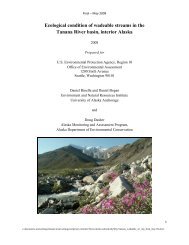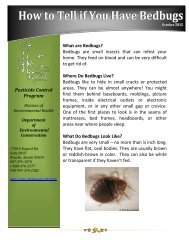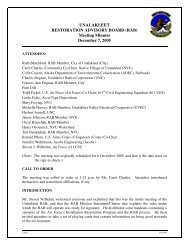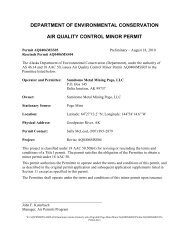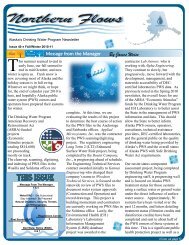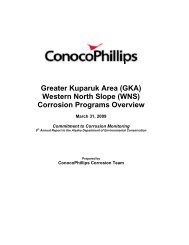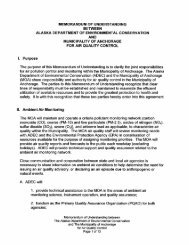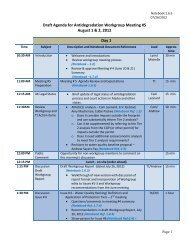2012 Ocean Ranger Guidebook Revision 3-7-12 - Alaska ...
2012 Ocean Ranger Guidebook Revision 3-7-12 - Alaska ...
2012 Ocean Ranger Guidebook Revision 3-7-12 - Alaska ...
You also want an ePaper? Increase the reach of your titles
YUMPU automatically turns print PDFs into web optimized ePapers that Google loves.
<strong>20<strong>12</strong></strong> <strong>Ocean</strong> <strong>Ranger</strong> <strong>Guidebook</strong> 3-7-<strong>12</strong><br />
Black Water (sewage) Examples - possible sources toilets, urinals and drainage<br />
from medical facilities (U.S. restriction).<br />
Bilge Water: Water that collects in the lowest inner part of a ship’s hull. Bilge<br />
water is frequently contaminated with oil and other lubricants from the engine<br />
room. Under various national and international standards, discharged bilge water<br />
must not exceed a certain maximum oil concentration (for example, 15 parts per<br />
million).<br />
Biological Oxygen Demand (BOD): An indirect measure of the concentration of<br />
biologically degradable material present in organic wastes. It usually reflects the<br />
amount of oxygen consumed in five days by biological processes breaking down<br />
organic waste.<br />
Black Water: Water contaminated with human waste, collected from shipboard<br />
toilets. Under various national and international standards, black water must be<br />
treated before being discharged from a vessel. Discharge: In this context, any<br />
solid or liquid material that emanates from a vessel to a body of water, including<br />
anything spilled, leaked, poured, pumped, emitted or dumped from the vessel.<br />
Black Water System: includes marine sanitation devices (MSDs) and other<br />
systems to treat, store, and discharge sewage. MSD approvals by USCG, IMO,<br />
or Administration Approved to MARPOL Annex IV.<br />
Chemical Oxygen Demand (COD): A measure of the oxygen required to oxidize<br />
all compounds, both organic and inorganic, in water.<br />
Conductivity: A measure of the ability of a solution to carry an electrical current.<br />
Conventional Parameters: Pollutants typical of municipal sewage. BOD, TSS,<br />
bacteria, oil and grease, and pH are defined as conventional by EPA. ADEC and<br />
USCG added suspended solids, ammonia, conductivity, chlorine, ammonia,<br />
phosphorus, total organic carbon, and chemical oxygen demand to the list of<br />
conventional parameters.<br />
CVE: Control Verification Examination is the examination of vessel for<br />
compliance with SOLAS requirements and applicable U. S. regulations. More<br />
properly referred to as the Passenger Vessel Certificate of Compliance<br />
Examination.<br />
Discharge: means any release, however caused, from a commercial passenger<br />
vessel, and includes any escape, disposal, spilling, leaking, pumping, emitting, or<br />
emptying.<br />
251






